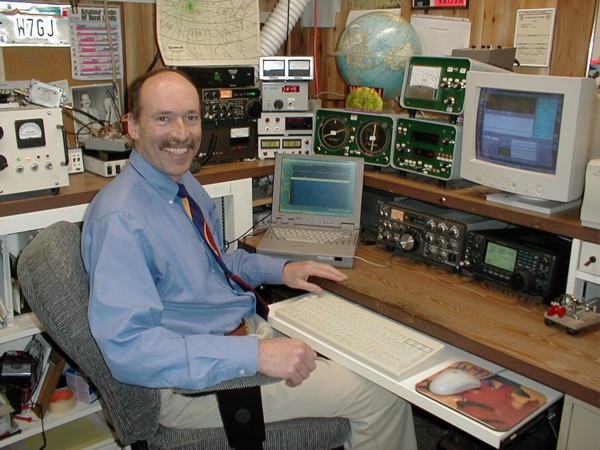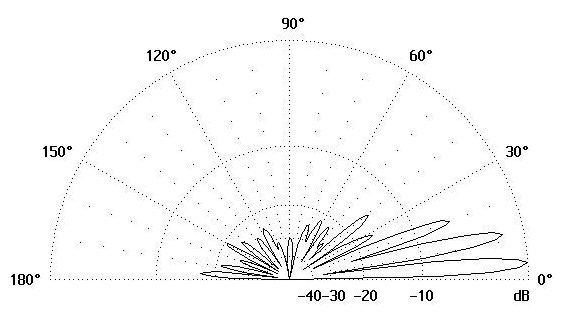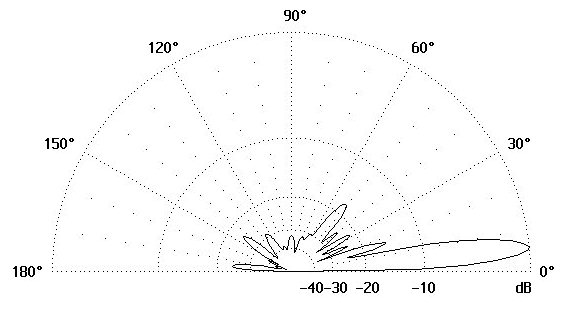WELCOME TO 6M EME!
6m Longest
Path Comes of Age
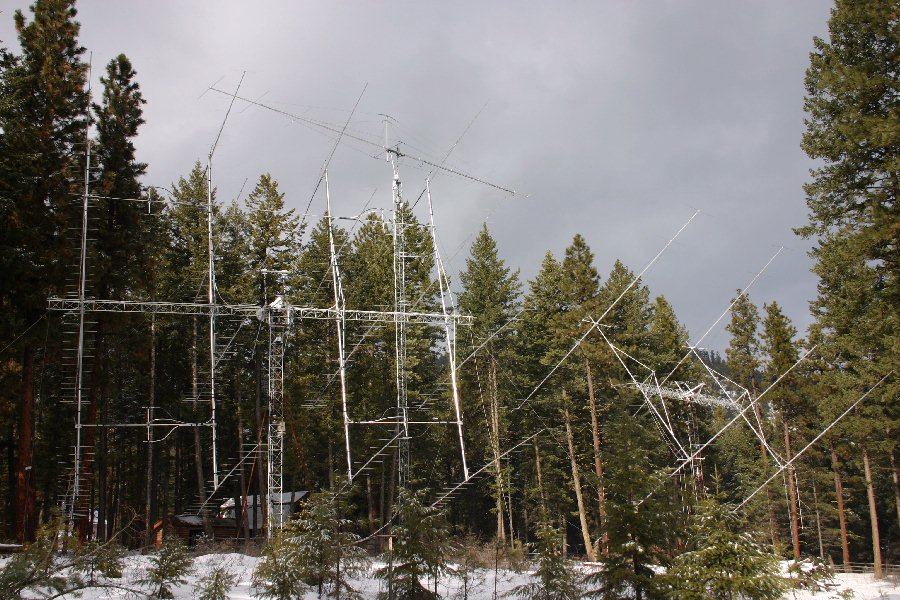 W7GJ EME antennas on AZ/EL mounts (L
to R): 16x17 el for 2m at 27' high, 11 el for 6m at 70' high, 4x9 el
for 6m at 32' high
W7GJ EME antennas on AZ/EL mounts (L
to R): 16x17 el for 2m at 27' high, 11 el for 6m at 70' high, 4x9 el
for 6m at 32' high
INTRODUCTION
What do you do on 6m during the solar cycle minimum, when conditions
most places around the world are like they always are in western
Montana? Don’t put away the 6m equipment for 10 years - make long
path contacts instead! I mean REALLY long path
contacts - like 800,000 km! Many 6m stations or DXpeditions
assume that
they don't
have a station capable of EME (Earth-Moon-Earth communications, or
"moonbounce"), and therefore never consider trying
it. But many who are willing to try it are surprised to learn
that
they actually do
have the capability of sending signals to the moon and back.
Working REAL
long path on 50 MHz is now very possible and unquestionably
brings magic back to the "Magic Band"!
In the three decades since the first 50 MHz amateur moonbounce contact
between the teams of Dick Allen (W5SXD)
and
Joe
Muscanere (WA5HNK - now W5HNK) in Texas, and Connie
Marshall (K5WVX - now K5CM) and
Sam Whitley (W5WAX - now K5SW) in Oklahoma, the playing field has
changed dramatically. That historic contact utilized
a pair of 8 yagi arrays, each aimed at the horizon! Previously
only an option open to a very few of the world’s largest stations,
moonbounce contacts are now within reach for most well-equipped 6m
stations. Until recently, an accomplishment such as making a
moonbounce contact on 6m EME was about an "S Unit" or two beyond the
reach of most stations. And when it comes to something like 6m
moonbounce, where signals are just
on the threshold of detectability, 5 to 10 dB is a HUGE amount!
However, several very significant developments have combined to make
this out-of-this-world type of 6m propagation practical today.
1) Computer-optimized antennas have significantly improved both
receive and transmit capabilities. The difference between the old
ubiquitous 5 element beam of 30 years ago and the computer-optimized
long boom 5 element yagi of today is substantial, and noticeable even
during non-EME contacts! And for those who are not inclined to
homebrew antennas, there are now some manufacturers of very high
performance computer-optimized 6m antennas. Remember, you only
need to aim the antenna at the horizon to work EME when the moon is
rising or setting!
2) Recent developments in equipment have incorporated 6m into
many new HF transceivers (some of which, such as the Elecraft K3, are even
already set up for digital mode operation on 6m!), and the band is also
included in a growing
number of new HF amplfiers. Inexpensive power tubes from Russia
have made it very easy to develop "legal limit" type of power output on
6m, and new
inexpensive transistors provide excellent performance from very
affordable receiver preamplifiers. The ready availability of such
equipment has made it very easy to assemble a first class 6m station
using “off-the-shelf” equipment. In fact, many well equipped HF
stations also already have all the 6m equipment they need for 6m EME!
3) New weak signal digital signal processing software that
can be
run by Windows computers has further narrowed the gap. The
very specialized weak signal mode of JT65A (included in the WSJT
computer program developed by Dr. Joe Taylor,
K1JT) provides an improved sensitivity of more than 10 dB compared to
CW, the previous mainstay for weak signal work. This innovation
has turned very difficult weak signal accomplishments like 6m EME into
very real possibilities for many hams. Any station that can
transmit PSK31 can operate on JT65A mode. WSJT Version 5.9.7 with
a complete English language User Manual is available for free download.
User
Manuals
in many other languages are also available here.
In
addition, to help bring new users up to speed, I have
prepared a list of JT65
tips.
The
author operating 6m
EME. The desktop computer monitor displays JT65, while the
laptop monitors the receiver audio using Spectran.
4) And, of course, it doesn’t hurt one bit that many households
have switched to either cable television or to satellite reception of
television signals, and old 49 MHz portable phones are rapidly being
displaced by inexpensive 900 MHz and 2.4 GHz portable phones. The
6m band has long held the reputation as the most difficult amateur band
to operate safely without causing interference. However, now many
of these most vulnerable household appliances are being improved
through newer technologies, making the 6m ham band much more attractive
again!
COMMON MOON WINDOW
The most basic requirement in order to contact somebody via the moon is
that both stations must be able to see the moon at the same time and
aim their antennas at it. Since the moon is visible to roughly
half the earth at any particular time, it is possible to contact
stations halfway around the world…that basically means you can contact
someone anywhere in the world using moonbounce. And because the
moon rises and sets every day, there are at least two times each day
when you can aim your antenna at the moon without elevating it off the
horizon. It is very easy to predict when you will have a "common
moon window" with a station somewhere else in the world, and to see
what days look like they will have the best conditions for EME.
My newly revised GJTRACKER
program for Windows is free for download and
quickly calculates future EME schedule possibilities.
DECLINATION CHANGES
Everyone knows that because the Earth is tilted on its axis, the sun
appears to move north and south in the sky over the course of the year,
as we orbit the sun. Similarly, the moon moves north and south in
the sky as it completes its monthly orbit around the earth. This
apparent deviation (referenced with respect to an imaginary plane going
through the earth’s equator) over the course of each month is called
the “declination”.
One
result
of this changing declination is that the length of the
“common moon window” between two locations on the earth changes every
day. What this means for moonbouncers is that you are provided at
least one
time each month when the moon is on the horizon for both stations at
the same time, so both stations can keep their antennas on the horizon
while they both are aiming at the moon.
STATION REQUIREMENTS
In short, a station with 1 kw output, a sensitive receiver or
external
preamplifier, ability to run the JT65A weak signal digital mode, good
low loss feedline, and a
good single yagi (over 1.5 wavelengths long) is an excellent candidate
for successful 6m EME
contacts. My first 6m EME contact was using a homebrew 7 element
yagi only 20' above the ground. After a number of attempts during
my moonrise, I finally completed a CW contact with SM7BAE who, in
addition to having the largest 6m array in the world, was very
patient. But that was in the days before WSJT and JT65A!
Although there still is nothing easy about 6m EME, using JT65A instead
of CW definitely increases the chances of success considerably!
Such a single yagi station should now be able to complete contacts with
other similarly-sized stations when the moon is on the horizon for both
stations. The simplest way to specifically assess your
capabilities and target other stations you can work, is to use the very
convenient "EME Calculator" that is found on the "EME ECHO MODE" screen
of the WSJT program (in Version
4.9.8 only). Whether or not your station is already wired
with a computer interface unit that will allow you to operate digital
modes, you can certainly download the WSJT program and run the EME
Calculator!
I usually suggest that a station have an antenna with 14 dBd gain if he
is interested in reliably working similarly sized stations. That
14 dBd gain can include ground gain, if he is primarily interested in
operating on the horizon. With 1500w output and 14 dBd from my
single long yagi, I could detect my echoes more than half the time when
pointed skyward and could often hear my own CW echoes weakly during
good conditions. Of course, when the moon passed
through my ground gain lobes during moonset or moonrise, signals were
significantly louder.
If you want to be able to contact
stations smaller than yours, or run
less power yourself, you will have to make up for the gain on your end
with a larger antenna. With my array of four long yagis, I have
completed contacts with numerous single yagi stations running between
400 and 600w, and with some single yagi stations using only 100w.
There currently are dozens of steerable four yagi stations around the
world, which makes it easy for single yagi horizon-only stations to
make EME schedules.
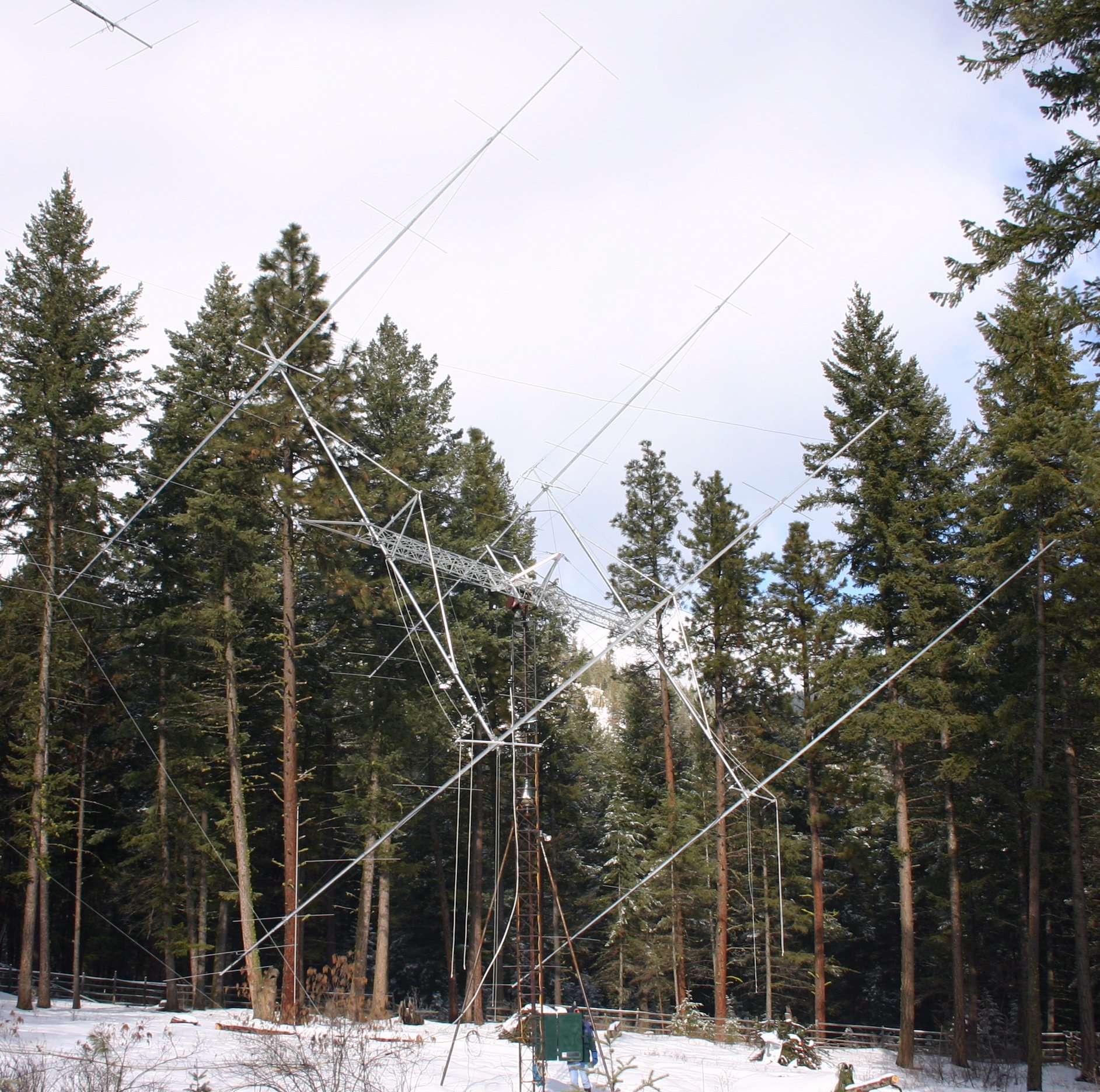
The
author standing at the base of his four yagi 6m EME array, manually
positioning the antenna after untying it.
Although not necessary to hear the larger stations, if you want to be
able to hear weak signals well, you will probably
also will want a good, low noise external receive preamplifier.
Most of the more popular transceivers that include 6m are optimized
for handling lots of strong stations rather than being most sensitive
to
detect weak signals. During periods of the month when EME
conditions are the best, the addition of a low noise preamplifier will
be a very welcome improvement at most 6m stations trying to capture the
really weak signals from the
moon.
GROUND GAIN - USE IT TO ADVANTAGE!
Many stations assume they have no EME capability because they cannot
elevate their antennas to track the moon. However, as discussed
above, there are certain times of month when two stations both can
“see” the moon without elevating their antennas. Actually, there
is a very real advantage in keeping antennas aimed at the
horizon! An antenna that is aimed at the horizon has “ground
gain”. This is extra gain that can often make the antenna perform
more like twice (or even 4 times) as many antennas! This
extra 3-6 dB
only is available at certain elevations, and depends on the local
terrain, the ground conductivity and the height of the antenna above
the ground. The signals reflected up to the antenna create
“ground gain lobes”, and when the moon passes in front of one of these
lobes, the signals can be greatly enhanced. That is exactly
how smaller stations are able to complete moonbounce contacts -
they keep their antennas aimed at the horizon and wait for the moon to
move into their ground gain lobes.
Figure
1
-
Ground Gain Lobes of Typical Single Beam Antenna 3.5
Wavelengths Above Ground
Notice that the first two lobes shown for my single yagi in Figure 1 have substantially higher
gain than the
third lobe. The third lobe is roughly equivalent to the “free
space gain” of the
antenna (how the antenna would perform if it were elevated and pointed
skyward). I have completed 6m EME contacts with many single yagi
stations while the moon was in their second ground gain
lobe. In the example shown in Figure 1,
the second ground gain lobe can be seen as having over 4 dB more gain,
compared to the third lobe, and only about 1.5 dB less gain than the
lower "main" lobe! Actually, for a number of reasons (discussed
below), the
second ground gain lobe sometimes even works better for EME than the
main lobe!
The closer the antenna is to the ground (or some other object or
antenna below the antenna that looks like ground), the higher the
ground gain lobes are raised. Conversely, the higher the antenna
is above
the ground, the lower the ground gain lobes. It also is not
unusual for an antenna that is only a few wavelenths high to have an
excellent lower ground gain lobe if the distant horizon is actually a
negative horizon (such as looking out over the ocean). This
situation frequently happens when a
station is located on a hill, or the smooth terrain is flat or dropping
away
in front of the antenna.
Beams that are stacked vertically only exhibit these same types of
multiple ground gain lobes when both antennas begin to approach the
same height above ground. This usually means that the center of
the stacked array has to be higher than 4 or 5 wavelengths above the
ground to have these same kinds of strong multiple ground gain
lobes. For antennas closer to the ground than that, each beam
has ground gain lobes at different elevations, so they cancel out
and/or “smear” into a single broader ground gain lobe. Figure
2 shows a typical vertical pattern for my 4 yagi array centered
at
approximately 1.75 wavelengths above the ground.
Figure
2
-
Ground Gain Lobe of Typical Stacked Beam Antenna
Centered 1.6 Wavelengths Above Ground
You can see the advantage that a single yagi offers for EME - the two
very good ground gain lobes offer twice as many chances for the moon to
line up with a lobe while the antenna is aimed on the horizon.
For an antenna that is used on the horizon, one single long yagi serves
as an excellent EME antenna.
CONDITIONS AFFECTING 6M MOONBOUNCE
6m is perhaps the worst and most unreliable band for EME, because
of all the things that can adversely affect the propagation at 50
MHz. You can easily understand why conditions may change rapidly,
and success may result only after numerous failed attempts. Since
signals are usually only marginal anyway, attempts at EME should be
scheduled to try to avoid as many of these
disruptive factors as possible. For that reason, most of the 6m
EME activity happens during times when conditions appear to be most
favorable, and people generally do not waste their time running
schedules during poor conditions.
1) One of the most common challenges faced by 6m operators -
especially if they keep their antennas on the horizon - is local
noise. Power line noise, interference from strong local broadcast
stations, industrial noise sources, automobiles, household appliances
(thermostats, motors, computers, etc.) - all can make it difficult to
hear weak signals. Ideally, attempts at EME should be scheduled
when local noise is at its minimum.
2) Aside from local noise, there are numerous types of phenomena
in the atmosphere and ionosphere that can interfere with 6m signals as
they travel out to the moon and back again. Es, F2, aurora,
generally disturbed geomagnetic field (a high Kp index or even a high A
index) have all been found to adversely affect 6m signals. Local
temperature inversions can “trap” signals along the earth, rather than
allow them to head out toward the moon. Many of these
adverse effects are difficult to predict in advance, while others can
be avoided by picking the correct time of day, or watching space and
local weather forecasts. In many cases, elevating an antenna (or
using the second ground gain lobe on a single yagi aimed at the
horizon) will reduce these adverse effects, by sending the signal
through less atmosphere/ionosphere. Of course, the geomagnetic
interference is far less, and the conditions are best outside the peak of the solar cycle!
3) Faraday rotation is rotation of the polarity of the signals as
they pass through the ionosphere. Often the polarity repeats
itself in about 15 minutes, but it can be “stuck” for long periods
(especially during periods of low Kp index, or when both EME stations
are in darkness), in
which propagation will appear to be “one-way” or wrong for both
stations. This is something which cannot be controlled or
predicted, but needs to be anticipated.
4) Perhaps the most predictable factors related to EME conditions
involve those related to the orbital motion of the moon. Every
month the moon moves close to the earth (perigee) and away from the
earth (apogee). The difference in signal path loss between these
two spots is over 2
dB - a very significant difference. On top of that, the moon
also moves through quieter and noisier parts of the sky. At 6m,
this
background noise can be significant and can mask the weak signals you
are trying to detect. The combination of these two factors,
compared to the ideal situation of the moon being at perigee and in
front of a quiet sky, is called the amount of “degredation”.
An
estimate
of this degredation is shown on the JT65A screen, as well
as
in my GJTRACKER
moontracking program.
SCHEDULES
Currently most 6m EME contacts are made by setting up schedules with
other stations in advance. Because of the relatively small number
of stations active at any given time, and the various operating and
propagation conditions that have to be taken into consideration, this
usually seems to make the most sense. Schedules are usually set
up via email, or through dedicated real-time websites such as the
N0UK JT65 EME
, the ON4KST 6m CHAT or the
ON4KST EME CHAT
pages.
Because almost all 6m EME activity uses the weak signal JT65A mode,
which does
not tolerate QRM, most frequencies are agreed to well in advance, and
frequencies with known or expected activity are avoided. In
addition, there are other local band use plans and government
regulations that further restrict the use of digital modes and/or EME
weak signal operation, so a suitable frequency often has to be
coordinated in advance, depending on where each of the stations are
located.
ACTIVE STATIONS
With the advent of JT65A mode, there are a growing number of
stations capable of operating 6m EME. Also, with the declining
solar cycle, an increasing number of 6m DXpeditions are adding 6m EME
to their toolkits. Over a third of my Magic Band countries
have been worked using EME, and many of those (i.e. CY9DH, ES8X, OJ0LA,
V36M, 9U0A, 7P8NK, EA8/G8BCG, D44TD, 9A8A, OX3LX, GJ8BCG/P, ZL8R,
KH0/KH2K, CN3A, V51W, 9N7JO, P29NI, TO5E, IS0/I0JU, 6W1SE, OM3RRC,
DX0JP, J68AS, ST2RS, YA1RS, 4X/ZL1RS, N8S, etc.) have been from
6m EME contacts with DXpeditions or portable operations. Having
completed with over 150 different EME stations in almost 90 different
DXCC, it is very difficult to provide a current list of the active EME
stations. Let it be said simply that there are dozens of 6m EME
stations around the world with steerable four yagi arrays, and of
course many hundreds who are capable of EME with horizon-only
antennas. One effective way to find potential schedule partners
is
to watch for "spots" of stations (on internet 6m activity pages or on
the DX Cluster) being heard via the moon.
THE FIRST STEP - TESTING FOR ECHOES
If you are interested in determining if your station is capable of
6m
moonbounce, you can start by simply listening for your own
echoes. Just send
a few dashes on CW when the moon is near the horizon passing through
your ground gain lobes on a day with very low degradation, and see if
you can hear your signals returning
from the moon approximately 2.5 seconds later. Don’t become too
discouraged if you don't hear them right away, or if they are not very
consistant - as you can see from above, there are lots of things that
will cause them to come and go! If
you can detect your own CW echoes, you most certainly can contact
similarly sized stations under similar conditions.
If you are set up for digital modes, the easiest way to test for echoes
is to use the WSJT “EME
ECHO MODE”. Echo mode will automatically test for your echoes and
display a record of precisely how strong they were.
RESOURCES
The following are some links to provide a starting point for those
interested in specifics regarding some of the subjects discussed above:
6m Preamplifiers:
http://www.hamtronics.com
http://www.elecraft.com/PR6/pr6.htm
HF/6m kw power amplifiers:
http://www.hfpower.com/new/a1000.htm
http://www.yaesu.com/indexVS.cfm?cmd=DisplayProducts&ProdCatID=102&encProdID=47ZAY%2Bq1XfE%3D&DivisionID=65&isArchived=0
http://www.icomamerica.com/amateur/amps/index.html
Dedicated 6m power amplifiers:
http://home.cshore.com/lunarlink/
http://www.command1.com/products.htm
http://www.intertronicsolutions.com/amateur/
http://www.pollak.sulinet.hu/elektro/pa_rev/pa_rev.htm#high_vhf
Computer-Optimized 6m Antennas:
http://www.m2inc.com/index2.html
http://www.tridentantennas.co.uk/Frames/Mainframe.htm
http://www.directivesystems.com/antenna4.htm
http://www.yu7ef.com/
Free moontracking program to calculate common window times and
degredation:
http://www.bigskyspaces.com/w7gj/tracker.htm
Free WSJT digital communications program for JT65A mode weak signal
work:
http://pulsar.princeton.edu/~joe/K1JT/
Interface units between computer and radio to operate digital modes:
http://www.westmountainradio.com/
Free programs to simply display received audio spectrum:
http://digilander.libero.it/i2phd/spectran.html
More information about 6m EME and using digital modes:
http://www.bigskyspaces.com/w7gj/JT65checklist.htm
http://www.bigskyspaces.com/w7gj/JT65.txt
http://www.bigskyspaces.com/w7gj/
http://www.on4ant.com/
CONCLUSION
Although 6m EME is very challenging and unpredictable, it also is
very
fulfilling and exciting when it works! And, for me, it is a very
welcome alternative to ionospheric propagation, which comes along far
less often out here in Montana! If you want to
experience some real magic, even when you think the 6m band is
"closed", consider giving 6m moonbounce a
try! You just might be very pleasantly surprised at the DX you
can work! See you off the moon!

On 6m EME, the Magic never ends...
This page last updated
on 12 January, 2009


